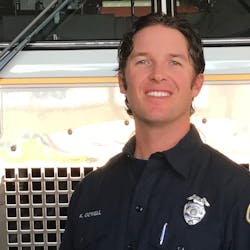There has been a lot of talk about cancer in the fire service lately. After researching this subject, it is apparent that exposure to toxic heavy metals from smoke, contaminated flood waters, and a process known as toxic “hand-off” has been overlooked.
According to the National Institute of Occupational Safety and Health (NIOSH), heavy metals—or cationic metal oxides (CMOs)—are known cancer-causing carcinogens. Toxic hand-off is the process of taking these contaminants from an incident and spreading them anywhere we touch, just like how germs are spread without washing your hands. Why is this significant? Heavy metals bind to skin and surfaces with a strong electrostatic bond and are not removed very well with commonly used (anionic) soaps and wipes.
Given a firefighter’s increased exposures to toxic chemicals from fires, it makes sense to try to mediate this exposure from as many directions as possible, particularly because even microscopic quantities of heavy metals are dangerous. When we are on a fire, we get covered in contaminates, which then are taken from an incident back to the station—and potentially home. We can address the toxic hand-off of unseen carcinogens by properly decontaminating equipment, PPE and ourselves. If we treat these unseen contaminants as germs, we can stop the spread and reduce our exposure.
Research on heavy metals
A study done by Underwriters Laboratory (UL) called “Firefighter Exposure to Smoke Particulates” collected smoke particulates containing multiple heavy metals, including arsenic, cobalt, chromium, mercury, lead and phosphorous. (Note: All fires are different, and hazmat exposures can be different from one fire to the next.) Further, according to “Characterization of Contaminants on Firefighter’s Protective Equipment: A Firefighter’s Potential Exposure to Heavy Metals During a Structure Fire” by Eastern Kentucky University, heavy metals were also found in soot. Other studies have shown microscopic amounts of cadmium, chromium, copper and lead adhere to turnout gear and equipment.
We are exposed to heavy metals on just about every fire we go on. And in today’s fires, we are not just exposed to natural materials burning; the synthetics used in households emit CMOs, which, as noted, are cancer-causing carcinogens. Firefighters have a higher likelihood of developing cancer over other occupations because modern fires contain chemicals and metals that didn’t exist in years past. For example, a burning carpet can yield lead oxide, stainless steel can flash off hexavalent chromium, and other metals come from burning exotic glues, finishes and electronics. Metal oxides stick to skin through a strong electrostatic bond, different from hydrocarbons, dirt, germs and grime; therefore, when we attempt to decontaminate after a fire, the current commonly used soaps and wipes are not sufficient for removing heavy metals.
Cleaning needed
For years, we have used regular soaps and wipes, but the cancer problem seems to continue, and may be increasing, so we should examine what makes up these soaps and wipes. Most soaps and wipes that are in widespread use today are based on anionic surfactants, and are not completely effective at removing metals. To identify an anionic soap or wipe, look for ingredients such as cocamidopropyl betaine, tetrasodium EDTA, sodium lauryl sulfate, sodium cocoate, sodium palm kernelate, parabens, betains, Aloe vera or other skin moisturizer (anionic-based cleaners require moisturizers, but moisturizers can help carry metal oxides deeper into the skin layers).
Cleaners and soaps that are cationic-based can safely remove toxic heavy metals as well as hydrocarbons from soot, dirt and germs, and do not dry out skin. Cationic-based products contain isostearamidopropyl morpholine lactate (ISML), and never any skin softeners or moisturizers. Developing an awareness among firefighters about the importance of appropriate skin and equipment decontamination cleaners should be an important part of preventing exposures to potentially cancer-causing elements.
Right now, we are most likely preparing our food and sleeping quarters with these CMOs, even after we consider ourselves clean. We are chronically exposed to heavy metals throughout a shift. We are repeatedly coming in contact with these toxins every time we respond to an emergency in our apparatus or train with our equipment that hasn’t been properly decontaminated. In my opinion, using regular anionic soaps and wipes may be making the problem worse, but if we use the correct products and treat these unseen toxins like we treat germs, we can stop the potential for toxic hand-off. Use of a cationic-based soap/cleaner can help us properly decontaminate ourselves and our equipment. The bottom line: A culture shift for science-based firefighter hygiene must happen, and we need to be more aware of these unseen killers.
References
- Fabian, T., Baxter, C.S., and Dalton, J.M. Firefighter Exposure to Smoke Particulates. April 2010. https://tinyurl.com/UL-ff-exposure.
- Dobraca, D. Israel, L., McNeel, S., et al. “Biomonitoring in California Firefighters.” Journal of Occupational and Environmental Medicine. 57(1) (2015). ncbi.nlm.nih.gov/pmc/articles/PMC4274322/
- Toxic Chemicals and Their Effects. Firefighters with Parkinson’s Disease: firefighterswithparkinsons.net/index.cfm?Section=8&pagenum=192&titles=0
- Hygenall Press Release: Hygenall Proposes New Firefighter Hygiene Practices. May 2017: hygenall.com/wp-content/uploads/2017/05/New-Firefighter-Hygiene-Practices-Press-Release.pdf
- Hygenall Firefighters: hygenall.com/firefighters
- LaMasters, G.K., Genaidy, A.M., Succop, P., et al. “Cancer Risk Among Firefighters: A Review and Meta-analysis of 32 Studies.” IAFF. iaff.org/hs/PDF/Cancer%20Risk%20Among%20Firefighters%20-%20UC%20Study.pdf
Sidebar: Heightened Cancer Risks
Multiple studies have confirmed that firefighters have a greater risk of getting certain types of cancers compared to the public. A white paper done by the Firefighter Cancer Support Network found that there is credible evidence and biologic creditability for statistically higher rates of multiple types of cancers in firefighters compared to the general American population, including:
- Testicular cancer (2.02 times greater risk)
- Multiple myeloma (1.53 times greater risk)
- Non-Hodgkin’s lymphoma (1.51 times greater risk)
- Skin cancer (1.39 times greater risk)
- Prostate cancer (1.28 times greater risk)
- Malignant melanoma (1.31 times greater risk)
- Brain cancer (1.31 times greater risk)
- Colon cancer (1.21 times greater risk)
- Leukemia (1.14 times greater risk)
- Breast cancer in women (preliminary study results from the San Francisco Fire Department)
Sidebar: Potential Chemical Hazards from Firefighting and Hazmat Exposure
- Arsenic
- Mercury
- Lead
- Cadmium
- Hexavalent chromium
- Cobalt
- Antimony
- Manganese
- Beryllium
- Vanadium
- Dirty bomb residue, including radioactive metals and oxides
- Dioxins
- Furans
- Pesticides
- Phthalates
- Plastic residues
- Volatile and semi-volatile organic chemicals (such as gas and oil)
- Drug and Chemical Residue such as fentanyl
- and many others!
Source: NIOSH
About the Author

Keith Cowell
Keith Cowell is a firefighter-paramedic with the Escondido, CA, Fire Department, where he has worked since 2005. He previously worked as a private medic in a 9-1-1 system prior to getting hired in the fire department.
